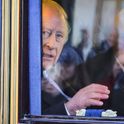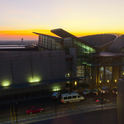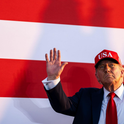
Three weeks into Putin’s war against Ukraine, Russia’s military performance has been surprisingly poor, exposing fundamental weaknesses in one of the world’s most powerful militaries despite years of large budgets and alleged reform.
One clear sign that the war is not going to plan for the Kremlin is its apparent urgent need for new troops and equipment. This is even more problematic for Russia than it might first appear.
Before the start of the war—a war entirely of Russia’s choosing and initiated on its timetable—Russia had stationed a large force of around 190,000 troops on Ukraine’s borders. This included troops brought over from many regions of Russia, such as the distant Eastern Military District; other forces included Chechen paramilitary units and Wagner group mercenaries.
Yet despite this show of force, unprecedented in Europe since the end of the Cold War, and less than a month into the conflict against a much smaller army, Russia has reportedly needed to redeploy its own troops from operations elsewhere and to seek assistance from others.
Last week, Putin announced that up to 16,000 troops were being recruited from Syria to help with the fight against Ukraine. This is a striking role reversal in the Russia-Syria relationship which was previously characterised by the Kremlin’s military support for the Assad government.
In recent days, the US government has claimed that Russia also requested military assistance from China; this is reported to include requests for a variety of weapons and other equipment including material as basic as military food kits.
At the same time there are reports that Russia is redeploying its own troops from inside and outside Russia. This appears to include the movement of troops from close ally Armenia, and from the secessionist Georgian territory of South Ossetia—a region recognised by Russia as an independent state and host to one of its “peacekeeping” presences.
The use of troops from South Ossetia (and the reported call for South Ossetian volunteers to join them) is particularly notable because of the risk to Russia’s wider geopolitical interests. South Ossetia is one of several secessionist areas in the former Soviet Union which the Kremlin has used to coerce the state to which it belongs. This ability to make use of so-called frozen conflicts has been one of the central instruments of Russian control over the region. As a result, it is critically important for its self-identification as a great power—for Putin, one of the core aspects of Russian national identity.
Withdrawing troops from these regions, particularly if it may not be able to replace them in the near future, risks loosening Russia’s grip. Combined with Russia’s political preoccupation with Ukraine, this creates opportunities for regional actors to take advantage on the ground. This is something that may already be happening in the South Caucasus, where Azerbaijan has attacked Armenian areas around the disputed region of Nagorno-Karabakh.
Outside the post-Soviet space, the appeal for assistance from China (denied by the Russian government) is profoundly humiliating for the Kremlin. Putin has made much of the relationship with Beijing, framing it as an alliance of rising great powers against an aggressive but declining west. Mere days into his war of choice, however, Russia appears less like an equal and more like a junior partner, forced to publicly deny that it is relying on the stronger state to feed and arm its troops. This may have implications not just for that bilateral relationship but for the way that Russia is viewed by other potential partners and allies.
Finally, beyond the immediate impact of these requests and redeployments on operations in Ukraine and on Russia’s reputation, there is another potential longer-term consequence which should be deeply concerning for Putin.
It seems most likely that additional forces are needed in Ukraine to replace the large numbers of dead and wounded troops. Whatever the attempts to conceal fatalities, perhaps with the use of mobile crematoria, families and others connected to Russian soldiers will notice when their sons and husbands and neighbours return wounded, or never return at all. As the prominent Russia analyst Mark Galeotti has noted, willingness to accept the official accounts of the war, and thus to accept the war itself, are likely to break down in these circumstances, as they did in the Soviet war in Afghanistan.
In that conflict, outrage over soldiers’ deaths led to the formation of grassroots groups such as the Committee of Soldiers’ Mothers—an important element in the development of wider civil society and ultimately one factor in the eventual collapse of the USSR. This is a scenario that those in senior military and political positions in Russia area clearly desperate to avoid, as the extraordinary repression of all anti-war protest—and even of the use of the term “war”—suggests.
In many different ways, then, the shortage of troops and equipment in Ukraine has exposed the extent to which the war is rapidly eroding Russia’s regional and international standing, and putting the political survival of Putin himself at risk. Whether he has a way out of this is very far from clear.










